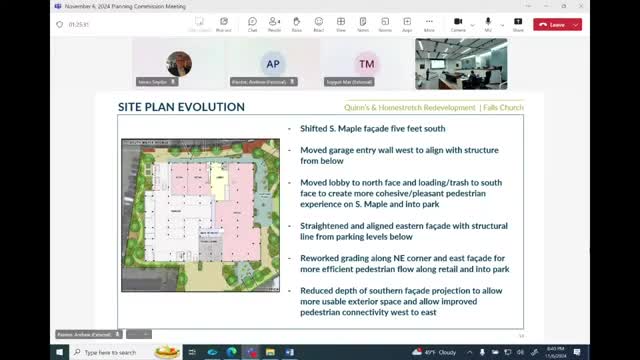Architects present cohesive design changes for mixed-use development along Maple Avenue
November 06, 2024 | Falls Church City, Fairfax County, Virginia
Thanks to Scribe from Workplace AI , all articles about Virginia are free for you to enjoy throughout 2025!

This article was created by AI using a video recording of the meeting. It summarizes the key points discussed, but for full details and context, please refer to the video of the full meeting. Link to Full Meeting
The meeting began with a detailed overview of the building's elevations, where the design team highlighted their efforts to maintain the character of the approved facade while enhancing its visual appeal. The architects noted that there would be no changes to the building's height or width, but adjustments were made to create a more cohesive look that aligns with pedestrian experiences. The color palette was preserved, ensuring continuity with the city’s architectural language.
One of the most discussed aspects was the transformation of the south elevation, which previously featured large, blank facades. The design team explained that these facades had been reworked to incorporate more glazing, allowing natural light to flood the interior and improving the overall aesthetic. This change not only enhances the building's appearance but also contributes to a more inviting atmosphere for pedestrians.
The east elevation, facing a nearby park, was also a focal point of the discussion. The architects addressed previous concerns about accessibility, revealing plans to eliminate cumbersome ramps and stairs. Instead, they proposed a seamless transition from Maple Avenue to the plaza, ensuring that all areas are accessible and inviting for residents and visitors alike.
Landscaping was another key topic, with the landscape designer presenting a vision for increased greenery around the building. The removal of a fire lane allowed for a more expansive green space, which is expected to enhance the overall environment and provide a welcoming entrance to the site. The design aims to create a vibrant outdoor area that can host community events and activities.
In addition to aesthetic improvements, the meeting also covered technical aspects such as stormwater management. The team outlined their commitment to reducing impervious surfaces by 11%, which will help manage runoff and improve water quality. They detailed plans for underground detention systems that will store and slowly release stormwater, meeting city requirements while promoting sustainability.
As the session drew to a close, the Planning Commission opened the floor for questions, signaling a collaborative approach to refining the project further. While public comments were not taken during this work session, the discussions highlighted a shared vision for a development that not only meets regulatory standards but also enriches the community fabric of Falls Church.
With these updates, the proposed building stands to become a landmark of thoughtful design and community engagement, reflecting the city’s commitment to progress while honoring its unique character. The Planning Commission's ongoing dialogue with developers and architects suggests a promising future for this project, one that aims to enhance the lives of Falls Church residents for years to come.
Converted from City of Falls Church Planning Commission Meeting November 6th, 2024 meeting on November 06, 2024
Link to Full Meeting
Comments
View full meeting
This article is based on a recent meeting—watch the full video and explore the complete transcript for deeper insights into the discussion.
View full meeting


